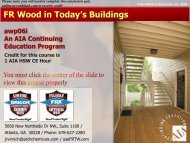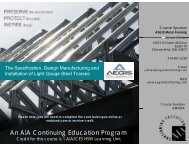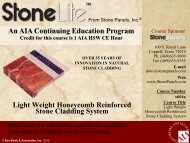Colloidal Silica - Ron Blank & Associates, Inc.
Colloidal Silica - Ron Blank & Associates, Inc.
Colloidal Silica - Ron Blank & Associates, Inc.
You also want an ePaper? Increase the reach of your titles
YUMPU automatically turns print PDFs into web optimized ePapers that Google loves.
© <strong>Ron</strong> <strong>Blank</strong> & <strong>Associates</strong>, <strong>Inc</strong>. 2011<strong>Colloidal</strong> <strong>Silica</strong>New Technology for Better ConcreteCourse Number: lyt03aPlease note: you will need to complete the conclusion quizonline at ronblank.com to receive creditAn AIA Continuing Education ProgramCredit for this course is 1 AIA HSW CE HourLythicSolutions, <strong>Inc</strong>.Brad SleeperP.O. Box 5028Vancouver, WAbrads@lythic.netPhone: 888 598 4421Cell: 503 860 9243
An American Institute of Architects (AIA)Continuing Education ProgramApproved Promotional Statement:<strong>Ron</strong> <strong>Blank</strong> & <strong>Associates</strong>, <strong>Inc</strong>. is a registered provider with The American Institute ofArchitects Continuing Education System. Credit earned upon completion of thisprogram will be reported to CES Records for AIA members. Certificates ofCompletion are available for all course participants upon completion of the courseconclusion quiz with +80%.Please view the following slide for more information on Certificates of Completionthrough RBAThis program is registered with the AIA/CES for continuing professionaleducation. As such, it does not include content that may be deemed orconstrued to be an approval or endorsement by the AIA or <strong>Ron</strong> <strong>Blank</strong> &<strong>Associates</strong>, <strong>Inc</strong>. of any material of construction or any method or manner ofhandling, using, distributing, or dealing in any material or product.
An American Institute of Architects (AIA)Continuing Education ProgramCourse Format: This is a structured, web-based, self study course with a final exam.Course Credit: 1 AIA Health Safety & Welfare (HSW) CE HourCompletion Certificate: A confirmation is sent to you by email and you can printone upon successful completion of a course or from your <strong>Ron</strong><strong>Blank</strong>.com transcript.If you have any difficulties printing or receiving your Certificate please sendrequests to certificate@ronblank.comDesign professionals, please remember to print or save your certificate ofcompletion after successfully completing a course conclusion quiz. Emailconfirmations will be sent to the email address you have provided in your<strong>Ron</strong><strong>Blank</strong>.com account.Please note: you will need to complete the conclusion quizonline at ronblank.com to receive credit
Course DescriptionLearn how colloidal silica nano-technology improves the integrity andbeauty of exposed concrete floors. Explore the chemistry behind thistechnology, its innovations, and application processes.
Course ObjectivesBy completing this course, the design professional will be able to:1. Discuss the role of densifiers and colloidal silica technologies interms of strengthening concrete.2. Compare and contrast colloidal silica technology and silicatedensifiers in terms of chemistry, performance, and applicationprocess and identify how these factors impact safety and theenvironment.3. Discuss various colloidal silica concrete floor innovations and theirapplication process.4. Identify the benefits of using colloidal silica on concrete floors andhow this impacts performance and longevity of a project.
Terms You Should KnowPozzolan – a material which, when combined with calcium hydroxide,exhibits cementitious properties.Densifier – substance applied to surface of concrete in order to fill poresand increase surface density.Diamond Polishing – a process which uses diamond tooling to polish afloor to a high reflectivity.Burnish – a process which uses non-diamond tooling or rubbing to polish afloor to a high reflectivity.<strong>Silica</strong>te – a highly caustic compound containing metal salts (high pH).Reactive <strong>Colloidal</strong> <strong>Silica</strong> – an engineered dispersion of nano-sized silicaparticles in an aqueous suspension, (no metal salts).Colloid – a suspension of solid particles in a liquid.Amorphous – without a clearly defined shape or form.Caustic – able to burn or corrode organic tissue by chemical action.Nanometer – one billionth of a meter.
Introduction
ConcreteConcrete plays a crucial role in today’s construction and design.It is a widely used building material made from cement, aggregatesand admixtures such as water reducers, plasticizers, and fly ash.Its many uses in construction projects include architecturalstructures both large and small, foundations, exterior landscaping,roads, parking structures, bridges, and much more.
Strength and FlexibilityThe wide use of concrete stems from its strength and durability.With a long history of use in construction, many ancient concretestructures still stand tall today, attesting to its longevity.The ease-of-maintenance further contributes to its durability, whilethe flexibility of concrete lends itself to a vast array of projects anddesign applications.
Aesthetic AppealConcrete is an increasingly popularchoice for its aesthetic qualities indesign, especially in flooring.Beautiful exposed concrete floors arecommon in restaurants, display rooms,high-end retail stores, museums,universities, and even homes.With its many aesthetic options forcolor, texture and levels of shine,concrete adds an appeal that’s bothtimeless and modern.
Concrete WeaknessesStill, because Concrete is first and foremost a structural material, itrequires specific chemical treatments and mechanical processing toovercome its inherent limitations as a finished surface material. Itsporosity makes it prone to staining, its vulnerability to acid attackcan cause surface etching, and its susceptibility to surface wear anddusting are natural characteristics of concrete that need to beconsidered for any finished protocol.Concrete hardeners, additives, and protectors are commonly usedto help resolve these issues.Historically, design professionals have used silicates in flooringapplications to densify and strengthen concrete. However,traditional silicates have many drawbacks including complicatedapplication, whiting, and hazardous application byproducts.
New TechnologyThrough the development of better chemistry, new reactive colloidalsilica technology overcomes the weaknesses of previous concretehardeners.Exhibiting a faster and more complete reaction with concrete,colloidal silica technology can now be found in a variety of concreteinnovations. From densifiers to cleaners, the chemical makeup ofthis technology adds strength and durability more efficiently andeffectively than hardeners of the past.
ApplicationsThe application of colloidal silica is easier and safer, requiring norinse and no hazardous waste – eliminating environmental impactsand health risks to those in contact.As a protectant, reactive colloidal silica improves the longevity anddurability of concrete floors beyond what silicates have been able toprovide.As a cleaner, colloidal silicacontinues to densify a concretefloor over time, creating a harder,longer-lasting, low maintenancefloor.
ApplicationsIn an overlay system, colloidal silica reacts with and densifiescementitious and non-cementitious surfaces where silicates fail.As a curing agent, applying colloidal silica as soon as the surface iswalkable creates a more complete reaction on the surface of theslab and, thereby, a harder finished surface.As an admixture, colloidal silica is the purest pozzolanic additive,reacting more quickly and completely with the concrete to provideearly strength.
<strong>Colloidal</strong> <strong>Silica</strong>New Generation Technology
What Is Reactive <strong>Colloidal</strong> <strong>Silica</strong>?Reactive <strong>Colloidal</strong> <strong>Silica</strong> is thepurest, most reactive advancedconcrete treatment technology.Processed from silicates, its makeupconsists of 99.5% pure silicasuspended in an ultra-low surfacetension liquid.
The Chemistry: Nano TechnologyThe particle size of the silica in colloidal silica is significantly smallerthan fumed silica particles at 5 nanometers. This creates a largerreactive surface which increases the volume of calcium silica hydrate,creating more CSH as it lowers the residual calcium hydroxide (acaustic crystalline byproduct) during and after cement hydration.CSH acts as a binder and imparts strength in concrete.When colloidal silica is added to concrete at the time of placement,compressive strength is increased. When added after hydration, theconcrete surface is “densified” as silica penetrates the surface tobond to the silica and calcium hydroxide to create CSH.
How it Works<strong>Colloidal</strong> silica works by reactingwith lime in concrete. Duringhydration, approximately 20percent of a concrete mixture’sportland cement is converted tolime, which has no structuralvalue in concrete.However, colloidal silicapozzolanically reacts with lime toform CSH strengthening crystals.
How it WorksConcrete also contains naturally occurring silica. Because silicabonds best to itself (a property not found in any silicate densifier)colloidal silica is able to build up more density and strength in aconcrete surface.It can be applied to new, hard-troweled floors, or to existing slabsafter light grinding.<strong>Colloidal</strong> <strong>Silica</strong>Microscopic view ofpore in concrete
Non-CausticThe silica in colloidal silica isamorphous and will not producehazardous crystalline dust. With a pHsimilar to baking soda, it contains lessthan one half of one percent metallicsalts and is far safer to handle thansilicates.No whiting
What It’s Used ForApplications to Design Projects
<strong>Colloidal</strong> <strong>Silica</strong> In ActionNow, lets take a more in depth look at colloidal silica innovations andconcrete treatments:Densifiers<strong>Silica</strong> polymer dispersion protectorsCleanersOverlaymentsCuring agentsAdmixtures
First-Generation DensifiersChemical densifiers can help concrete to acquire a better polish andmake that polish more durable because they increase abrasionresistance.First-generation concrete densifiers were made from silicates, suchas sodium silicate and potassium silicate; this range of silicate-basedcompounds later broadened to include lithium silicate. Thesecompounds are highly caustic, with a pH of 11 to 13, similar to thealkalinity of lime itself.
First-Generation DensifiersThe process of applying thesedensifiers can generate a caustic,gelatinous slurry that must bethoroughly scrubbed off and disposedof as hazardous waste.The high pH (alkalinity) of silicatesmakes them unpleasant for applicatorsto handle. In fact, some cities andstates are imposing tighter restrictionson how and where the slurry ofsilicate hardeners can be disposed of.Caustic materialHazardous waste disposal
<strong>Silica</strong>te Densifier ApplicationSodium silicates react with Calcium Hydroxide in concrete toliberate silica from the sodium ion that keeps it insuspension. Unfortunately, sodium will impede silica bonding as itcompetes with it for bonding sites. <strong>Silica</strong>tes ratio of one partsodium to 3 parts silica is a limiting factor in the potential fordensification of any concrete slab.Once applied, the densifier must becontinuously agitated with a broom toassist in penetration and chemical reaction.Time for application can take up to 60minutes or more.The silica/calcium hydroxide reactioncreates a caustic gel which then must bediluted/hydrated with water to continuepenetration, and then followed by morebrooming.
<strong>Silica</strong>te Densifier ApplicationAfter hydration, extraction of the surface residue is required toprevent “whiting.”Again, because silicates are caustic (pH 11-13), any residue orresidual slurry must be treated as hazardous waste.Whiting from incompleteextraction
<strong>Colloidal</strong> <strong>Silica</strong> Densifiers<strong>Colloidal</strong> silica densifiers produce no excess mineral salts (whichdiscolor concrete) and no “whiting,” even if over-applied.Due to a smaller silica particle size, reactive colloidal silica has morereactive sites on the molecule than silicates and, therefore, formschemical bonds more readily. It fills the pore structure moreconsistently, making an extremely hard, dense floor surface that hasincreased wear resistance to foot and fork lift traffic.Damaged concrete that is soft and dusting can be improved withapplications of colloidal silica, enabling the floor to take a polish.
<strong>Colloidal</strong> <strong>Silica</strong> Densifiers<strong>Colloidal</strong> silica is up to1000 times less caustic than silicates, makingit safer for workers to handle and safer to use near other finishedsurfaces. Any application residue is non-toxic.Application of colloidal silica densifiers are easier and moresimplified; and unlike some silicates, there is no overnight curingrequired – speeding up project times.There is no disposal of hazardous material – reducing environmentalimpacts and health risks.No hazardous waste
<strong>Colloidal</strong> <strong>Silica</strong> Densifier ApplicationApplication simply involves applying the densifier via a spray-pumpapplicator and reapplying as needed to keep the surface wet for 15minutes.After the slab is allowed to dry for approximately one hour, it isready for polishing to a high reflective shine.Overnight waiting is not required,consequently eliminating theextra transportation-related energyconsumption of returning to thejobsite common when using silicatedensifiers.
<strong>Colloidal</strong> <strong>Silica</strong> Densifier Application - Polishing<strong>Colloidal</strong> <strong>Silica</strong> Densifiers can be used in either a diamond polishedor non-diamond polished (burnished) application.In either application, there is no removal step—only a small amountof non-crystaline dry powder residue that is vacuumed up duringthe polishing process.
Alternative to Diamond Polishing<strong>Colloidal</strong> silica is also at the foundation of a new polishingalternative that provides all the benefits of a polished floor withoutthe expense of diamond polishing.This non-diamond polished floor process uses the application ofcolloidal silica engineered in two nano sizes that effectivelyimpregnate the surface with a veneer of silica that can be burnishedto a reflective shine.
Non-Diamond Polishing Process The base layer of colloidal silica containing silica particles of 5nanometers forms a bonding surface (or landing pad) for a secondlayer containing silica particles of about 45-nanometers.These larger particles quickly build up density in the surface andmay actually fill in finer scratch patterns.
Non-Diamond Polishing ProcessAfter the floor dries (one hour), excess silica is picked up by a floorscrubber using a floor stripper pad and water. Again, there is nowhite crystalline residue to remove.An acrylic co-polymer protector solution formulated with silica andlithium is then applied and allowed to dry (one hour). The floor isthen burnished to give it its final shine.
Why Non-Diamond Polished Floors?Industrial concrete floors have a highstrength mix and are placed with amechanically consolidated surface.The non-diamond polished alternativeprocess adds reflectivity withoutgrinding off the mechanically densifiedcap.And again, beautiful reflective surfacefloors are achieved while saving onexpenses and other resources.
SavingsTreating concrete floors with colloidal silica densifiers, whether usedas a densifier in diamond-polished or non-diamond polishedapplications, consumes less resources and lowers costs—saving ontime, labor, and scrubbing equipment.The tables on the next two slide illustrate the savings of usingcolloidal silica in comparison to conventional silicate densifiers.TimeLaborEquipmentMaterialsDollars
Savings<strong>Colloidal</strong> <strong>Silica</strong> DensifiersConventional <strong>Silica</strong>teDensifiersSpray-On Application YES NOScrub-in Application NO YESPotential Water Damage NO YESApplication Time 15 min. 60 minLabor 1 worker 3 workersEquipmentHand Sprayer ($30) orPower Sprayer ($200)Autoscrubber ($6000)Set Time 1 hour 12 hoursScrub-Off Time NO YESScrub-Off Labor NO YESScrub-Off Disposal NO YESSpills of Scrub-Off Slurry NO YESWhiting Potential NO YESAutoscrubber Transport NO YESAutoscrubber Maintenance NO YES
SavingsThis is one example of an average cost comparison between <strong>Colloidal</strong> <strong>Silica</strong> treatmentsand <strong>Silica</strong>te-based treatments
<strong>Silica</strong> Polymer Dispersion Protector<strong>Colloidal</strong> silica technology can also be found in silica polymerdispersion protectors for treating concrete floor surfaces. Thistechnology combines a water-borne modified epoxy polymer withreactive silica. The result is a breathable, densifying sealer that formsa tough, clear, chemically bonded protection layer which is alsoformulated to increase water repellency and traction.Third party lab testing with strong acid as well as with oil resulted inonly mild discoloration after 24 hours of exposure. Thisdiscoloration buffed out of the protection layereasily; no permanent damage to theconcrete occurred.Protects from etching,staining, etc.
Independent TestingStain and Acid Etch Protection(motor oil, brake fluid, vinegar, red wine,acetone, muriatic acid)NO PENETRATIONNO PERMANENT ETCHINGTypical average COF for 800 diamond polish..65 to .75 dry.60 to .65 wetAfter application of protector.78 to .9 dry.70 to .80 wet
Independent TestingAbrasion Resistance: Three, 1” top sections of 4” concrete test cylinderswere “screened”, densified and received one application of the protector.Testing was done on a Tabor Abrasor with two coarse carborundumwheels “loaded” with1 Kg. Samples were ground for 7.5 minutes achieving500 cycles.Micrometer measurement showed significantly less wear on the treatedsamples compared to the untreated after 250 cycles. 2 of the 3 samplescontinued to show less wear through 500 cycles.
<strong>Silica</strong> Polymer Dispersion ProtectorA silica polymer dispersion protector can be easily applied using amicrofiber applicator. It dries within two hours, and can beburnished to a deep gloss in 12-24hours.Its highly resilient surface re-shineseasily with lightweight burnishing orscrubbing machines to help maintaina glossy, clean, attractive appearancewith applications ranging fromwarehouses, to restaurants, to retailstores.
<strong>Colloidal</strong> <strong>Silica</strong> CleanersA cleaner that incorporates colloidal silica technology not onlyremoves dirt and other surface impurities, it also continually fortifiesthe floor surface.Whereas silicates do not “bond,” the colloidal silica within a cleanermolecularly bonds to the concrete surface, building a harder surfacewith each cleaning. Resistance to abrasion and liquid penetration isimproved and floor maintenance is easier.
<strong>Colloidal</strong> <strong>Silica</strong> CleanersThese cleaners can be used in auto scrubber machine cleanings. Norinsing is required.They can also be used in mopping applications.
<strong>Colloidal</strong> <strong>Silica</strong> Overlay SystemsMany cementitious overlays today are self-leveling systems madewith specialty cements, as opposed to ordinary portland cement.These systems allow for minimal thickness buildup. These modifiedcement products have less residual lime available with which toreact.These systems also exhibit lower abrasion resistance due to lowaggregate content and benefit immensely from fortification withsilica.However, with less CalciumHydroxide available to them,silicate densifiers have such alimited opportunity to react thatthey are, for the most part,ineffective.
<strong>Colloidal</strong> <strong>Silica</strong> Overlay Systems<strong>Colloidal</strong> silica is chemically unique in its capability to react with thehigh silica content of specialty cement products to create a durablebonded topping with high reflectivity.It sometimes happens that theslab specified to be polished is notsuitable. The polished overlay canadd $6- $9 per sqft. more than theoriginal spec in the budget. Anoverlay system utilizing colloidal silicatechnology and non-polishedtechnique will add as little as $3-$5per sqft. – making it a cost efficientalternative as well.
<strong>Colloidal</strong> <strong>Silica</strong> Curing AgentWhen applied as a curing agent, reactive colloidal silica fills the poresat the surface of the newly placed slab and reduces watertranspiration from the slab creating a longer period of cementhydration.The concrete cures at a higher strength because the added silicabonds with calcium hydroxide created during the cement hydrationreaction.
<strong>Colloidal</strong> <strong>Silica</strong> AdmixturesAdmixtures are generally added toconcrete mixes in order to increaseworkability, strength, and durability.Fly ash and silica fume are probablythe most common admixtures usedin cement mixes, known for theirpozzolanic qualities.Pozzolans react with calciumhydroxide in cement to producehigh strength and low porosity.<strong>Colloidal</strong> silica contains the samemain pozzolanically reactiveingredient as fly ash and silica fumewhich is, of course, silica.
<strong>Colloidal</strong> <strong>Silica</strong> AdmixturesThe smaller the silica particles, the more potential for reaction.As stated earlier, the 5 nanometer size of silica particles in colloidalsilica creates more surface area for greater reaction to occur –improving early strength in the curing process as well as long-termstrength throughout the life of a project.Fast reacting and facilitating amore complete curing process,workers are able to get on slabsooner – cutting days off ofconstruction schedules.Calcium <strong>Silica</strong> Hydrate Crystal
Case Studies
Eileen Fisher Clothing Store – Irvington, NYIn support of sustainability, a high-endretailer, Eileen Fisher, wanted to recycle3000 square feet of space in the formerBurnham Furnace works, a large 103-yearoldbuilding in Irvington, NY.For a highly sustainable flooring surface,they refurbished the existing concrete.<strong>Colloidal</strong> silica densifier was chosen for itssustainable and non-caustic qualities – aswell as for its time-saving application.The crew stained the floor gray to unifythe varying shades of concrete, and thendiamond-polished it to a high gloss. Thegrinding was time-consuming, but using thefast-applying and fast-acting colloidal silicadensifier helped. They completed the job inone week. The owner was very pleasedwith the speed and beautiful result.“It was the ability to maintain this floor for 20 yearswithout petroleum products that will pollute theenvironment…Most other floors need waxing and stripping,and all that goes down the pipe.”Matt Johnson, owner of Savaspace <strong>Inc</strong>. and project Contractor
Killingworth True Value – Killingworth, CTKillingworth True Value in Killingworth, CTwas one of the first to integrate thecolloidal silica, non-diamond polishedalternative into their facility.Because construction took place duringwinter where temperatures were 40ºF, theapplication of epoxy would have normallyrequired the building to be heated andtemperatures maintained during an entirecure time of 24-48 hours.The application of colloidal silica using thenon-diamond polished process eliminatedthe need for heating, resulting in significantenergy cost savings.The result is an abrasion resistant, costeffective floor that is attractive and is easyto maintain.“When new, you can't tell the difference between a400 grit [non-diamond polished, colloidal silicadensified floor] and a 3000-grit diamond polish.”Nathan Christner, Project Contractor
Korry Electronics – Everett, WA A Washington state high-tech plantneeded a floor that could stand up toabuse, was easy to clean, was cost effectiveto make, and looked good enough forentertaining guests.The facility is used for assembly of hightechavionics equipment. It has strictoperating conditions, such as humiditycontrolled at 78%, and high attention tocleanliness. It is also frequently visited bycustomers. Acrylic flooring was considered notdurable enough. Polished concrete offeredthe durability, appearance and easymaintenance they sought, but it wasbeyond their budget. Alternatively, colloidal silica densifiercoupled with the non-diamond polishedfloor technique provided a durable, highsheen,easy-maintenance floor – resultingin a savings of approximately $120,000.“It’s turned out to be a very tough floor...We drive tuggersand forklifts across it; we slide all sorts of things acrossthat floor. It holds up well.”Steve Sullivan, Maintenance Facilities Technician
EWEB Operations Center – Eugene, ORThe new Operations Center of the Eugene Water &Electric Board was attempting LEED Goldcertification. The owner wanted an exposedconcrete floor that was durable, stain resistant, andattractive.The floor was originally specified for hardeningusing a magnesiumflurosilicate hardener. However, itwas feared that the extensive water-flushing neededby this product would allow the chemicals tocontaminate the building’s eco-friendly septicsystem.Instead, the contractor suggested densifying with amore eco-friendly colloidal silica densifier andprotector, which does not require flushing. Afterallowing the surface to cure for twelve hours, it wasthen burnished with a high-speed floor burnisherand a fine diamond pad (1500-grit or 3000-grit) toachieve a reflective, slightly wet look.To protect this floor with an epoxy system wouldhave cost $4-5 per sqft, a cost that wasunacceptable to the owner. Protection with silicapolymer dispersion solution cost was $0.75 persqft., resulting in a substantial savings.
Course Summary
Course SummaryNow the design professional will be able to:1. Discuss the role of densifiers and colloidal silica technologies interms of strengthening concrete.2. Compare and contrast colloidal silica technology and silicatedensifiers in terms of chemistry, performance, and applicationprocess and identify how these factors impact safety and theenvironment.3. Discuss various colloidal silica concrete floor innovations and theirapplication process.4. Identify the benefits of using colloidal silica on concrete floors andhow this impacts performance and longevity of a project.
© <strong>Ron</strong> <strong>Blank</strong> & <strong>Associates</strong>, <strong>Inc</strong>. 2011<strong>Colloidal</strong> <strong>Silica</strong>New Technology for Better ConcreteCourse Number: lyt03aPlease note: you will need to complete the conclusion quizonline at ronblank.com to receive creditAn AIA Continuing Education ProgramCredit for this course is 1 AIA HSW CE HourLythicSolutions, <strong>Inc</strong>.Brad SleeperP.O. Box 5028Vancouver, WAbrads@lythic.netPhone: 888 598 4421Cell: 503 860 9243
















